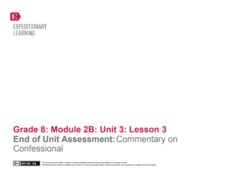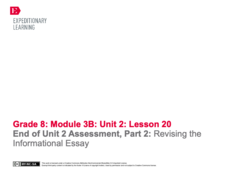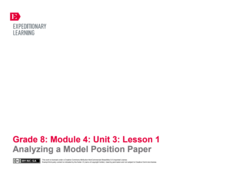EngageNY
Close Reading: Louie’s Change of Heart
Scholars read additional pages in Unbroken to discover more about Louie's character. Readers use turn-and-talk strategies to discuss character traits that describe Louie. They then answer text-dependent questions and cite evidence to...
EngageNY
Launching The Performance Task: Building Background Knowledge: “War in the Pacific,” Part 1
It's all about a bit of give and take. Scholars silently read War in the Pacific and circle any unfamiliar words. Using context clues, they write each word on a strip of paper along with the inferred definition. After looking the word up...
EngageNY
Building Background Knowledge: The Pearl Harbor Attack: Unbroken, Pages 38–47
Perspective changes everything. Scholars use a close reading guide while analyzing pages 38-47 in Unbroken. Readers learn that the governments of Japan and the United States had very different perspectives about the attack on Pearl...
EngageNY
End of Unit Assessment: Commentary on Confessional
What does commentary have to do with narrative? Before scholars explain the narrative choices in their Character Confessionals, they review provided commentary to explain the score they received on previous assessments. They review...
EngageNY
Key Incidents Reveal Aspects of Character: Survival at Sea (Pages 114-168)
Learn from experience. As part of their study of Unbroken, scholars use a turn-and-talk strategy to discuss Louie's experiences and the presence of God while he is lost at sea. They then read quotes from the text and infer what the words...
EngageNY
Building Background Knowledge: The Internment of Japanese-Americans during WWII, Part 1
It is all in the details. Scholars read The Life of Miné Okubo and pay special attention to details that reveal Okubo's character. Completing their Understanding Miné: Character Traits graphic organizers and recalling the descriptions...
EngageNY
Building Background Knowledge: The Internment of Japanese-Americans during WWII, Part 4
Learners use a Analyzing Mediums handout to detail the advantages and disadvantages of communicating with mediums such as artwork, photographs, and political cartoons in the Japanese-American Internment during World War II primary...
EngageNY
Mid-Unit Assessment: Classifying and Evaluating Primary Sources
Let's take a walk—a gallery walk. Scholars complete a mid-unit assessment relating to Unbroken by taking a gallery walk to view the various primary source mediums. They then use organizers to select three sources and respond to...
EngageNY
Final Performance Task: Presentation of Photograph and Song Selections
The presentation is the thing. Learners combine all their skills by creating a pitch for their films about the Little Rock Nine. They explain to classmates why they selected the images and songs using self-created prompt cards. The end...
EngageNY
Analyzing the Power of Different Mediums: A Mighty Long Way
Weigh the pros and cons. Class members continue sharing their thoughts on media and events by watching the video John Chancellor Reports on the Integration at Central High School. They discuss the advantages and disadvantages of gaining...
EngageNY
Informational Essay Planning: Analyzing and Selecting Evidence
Class members look again at the end-of-unit essay prompt for A Mighty Long Way. After reviewing the requirements of the essay, they use their Gathering Evidence note-catchers and color-code the evidence that matches the two questions in...
EngageNY
End of Unit 2 Assessment, Part 2: Revising the Informational Essay
Writers look at the End of Unit 2 Assessment: Best First Draft of an Informational Essay handout and use sticky notes to identify things in their work that need editing and revising. They reference their notes to finalize their...
EngageNY
Analyzing a Model Position Paper
What's the difference between a position speech and a position paper? Scholars use a rubric to analyze a model essay about Michael Pollan's food chains to understand what makes them unique. Additionally, pupils create anchor charts...
Curated OER
Using Homographs
Not all homographs are the same! Actually, that's exactly what the definition means; the spelling is the same, but the meanings are different! Look at some common homographs with your class. Example words include: bow, desert, produce,...
Newspaper Association of America
Using the Newspaper to Teach the Five Freedoms of the First Amendment
Of all the amendments found in The Bill of Rights, the First Amendment contains some of the most important freedoms for American citizens. A unit plan on the First Amendment features interactive lesson plans designed to teach about those...
University of North Carolina
Reorganizing Drafts
Poor organization often destroys an otherwise good paper. After writing a first draft, individuals consider the organization of ideas, a topic discussed in the 16th handout in the 24-part Writing the Paper series. The resource covers...
Lessons on American Presidents
Abraham Lincoln
Honor Abe Lincoln with a set of activity-based worksheets that can be used independently and in collaborative groups. Young historians participate in a listening activity where they fill in the missing blanks in a passage while being...
K20 LEARN
Just Say No!: Exploring Temptation Through The Lotus Eaters
Teenagers face many temptations, and just saying "No!" can be very difficult. Here's a lesson that provides some help. Learners use a Venn diagram to compare and contrast excerpts from The Odyssey, Tennyson's "The Lotus-Eaters," and the...
Curated OER
Diction: Formal and Informal Language
Coke or Pepsi? Is it the taste or the advertising that determines preference? As part of a study of diction, class members examine two passages, one formal and one informal, about Coca-Cola and Pepsi. In addition, they consider word...
Curated OER
Poetry Assignment Instead of a Test
"The Last Song" by Bernie Taupin and Elton John is the inspiration for an analysis assignment. Individuals read the song and answer nine questions about the speaker, figurative language, and significance of the lyrics. Use this as an...
Curated OER
Figurative Language: Similes
How does one identify a simile, and why is it important to understand what they are? Here's a very basic review. This short presentation defines the term, provides examples, and gives learners a chance to identify which two things are...
Road to Grammar
Five Presentation Tips
Talking in front of others can be intimidating, especially when you aren't speaking in your native language. Put your English language learners at ease before a class presentation. They can follow these tips to give relaxed and effective...
Curated OER
Linguistic Humor and Language Play
By George, there are so many literary devices illustrated here! Help your pupils create interest in their writing by presenting one or two of these literary devices at a time. The slides contain examples and beg participation from the...
Curated OER
The Boy in the Striped Pajamas: Graphic Organizer: Venn Diagram
Compare and contrast the characters in John Boyne's The Boy in the Striped Pajamas. Using a Venn diagram, kids write in different traits to describe each person, and note their shared characteristics in the middle section.

























